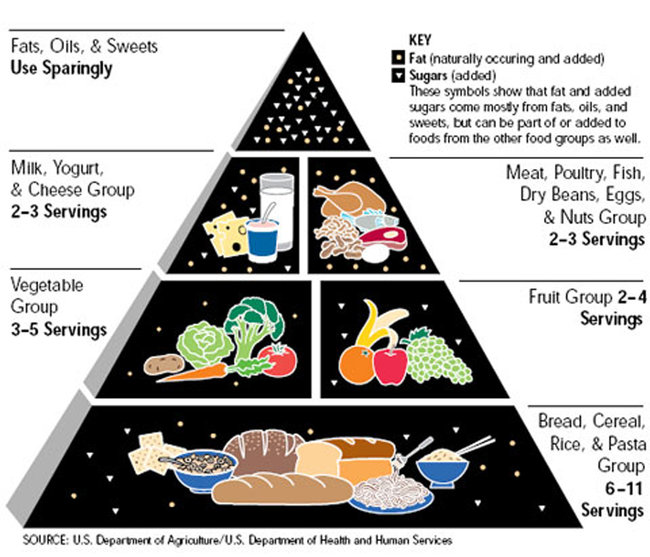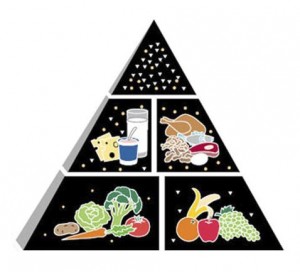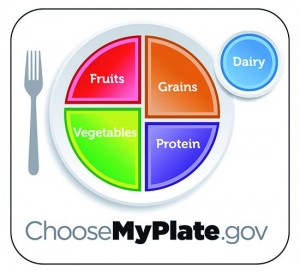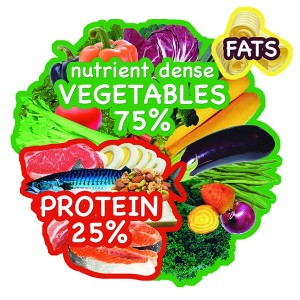The once ubiquitous food pyramid has now been replaced by my MyPlate, but it doesn’t hurt to examine it one more time to understand where we came from in terms of food recommendations.
For a better understanding of how the food pyramid came to be, a great read is Denise Minger’s Death by Food Pyramid. In spite of its funny, not-so-subtle title, it is a very serious investigation of the forces that conspired to create the monster.
On the topic, see also Marion Nestle’s Food Politics. Marion Nestle was the editor of the 1988 Surgeon General’s Report on Nutrition and Health.
In this post, we’ll just comment on the result:

The pyramid implies that starches (grain, cereals, bread) should constitute the basis of our food. This might have been true at the dawn of mankind, when calories were scarce. Agriculture and grains allowed large populations to be fed, and with the division of labor came the arts, politics, war, in short, civilization. But when consumed on top of everything else we eat now, grains become a liability: our body is not equipped to deal with the large amounts of starch and sugar that are effortlessly available nowadays.
The popular belief is that starches are needed for energy. This is plainly not true (but this will require a separate blog post to itself).
Fats appear at the very top of the pyramid: the proportion is not so bad (after all, fats are very dense nutritionally, and a little bit goes a long way), but it instills an unnecessary fear of fats: fat plays an important role in our body, we need fat for our brain, membranes and more.
The popular belief is that eating fat makes you fat. This is also false. (Look for a future post on the subject.)

The rest of the pyramid is more or less OK. We could argue that fruits are not really necessary since you get more vitamins and micronutrients from non-starchy colorful vegetables than from fruit, but this is in the noise level compared to the rest. So in fact, the food pyramid would not be so bad if we just cut off its bottom.
MyPlate
The “MyPlate” recommendation is a slight improvement over the food pyramid. But:

- Even though it has reduced the recommended proportion of grains, it still implies that grains are a basic food group.
- We don’t agree that grains are a food group, or that fruits are necessary at all.
- The proportion of proteins in “Myplate” seems reasonable, but the fats are completely missing from the picture.
- In our mind, dairy is not necessarily a glass of milk (as implied by the drawing), and not an add on: it is part of the protein and fats.
Grains are not a basic food group!
The indispensable, basic macronutrients are:
– Proteins
– Fats and
– Carbohydrates.
Cereals, starches and grains are not a separate food group: they are mostly carbohydrates. Eating a balanced diet doesn’t imply that you must include a proportion of starches and grains. Eating colorful, nutrient-dense vegetables will bring a fairly large amount of carbohydrates and fiber.
The ERFOE Ideal Plate

The plate that we advocate consists of:
• 1/4 Proteins
• 3/4 Colorful vegetables
• Fats
• No sugars or starches or cereal
This “ideal plate” is designed to provide enough micronutrients and macronutrients. Proteins can be animal or vegetal. They include meat, fish, poultry, eggs, dairy, nuts and seeds.
It is assumed that vegetables are cooked or seasoned with fats. Protein generally comes with built-in fat. Fat is important and greatly contributes to satiety: in the vegetable portion of your plate, half of the calories might come from fat (this is, however, not much in volume).
If you found this post interesting,
sign-up to be notified when there is a new post on our blog.

I completely agree! Our dietary needs can be fulfilled simply, without the other avenues currently being advocated.